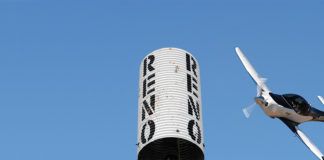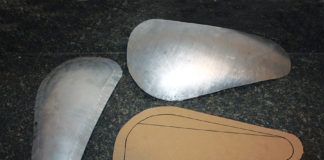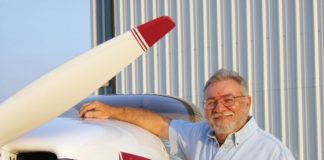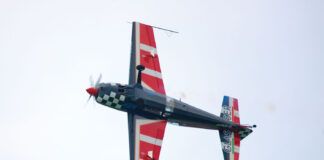Ive gotta see this! my friend Ace Rodriguez chuckled as we ambled between the exhibition hangars. AirVenture 2007 (OK, Oshkosh) had rolled around-my 13th-and I was about to participate in my first hands-on building workshop. Feeling like a freshman again, I scanned the tiny print in the schedule and picked out three workshops: Sheet Metal Basics, Composite Construction and Fabric Covering. I had no experience in any of the skills required (save ironing), and was about to get some clean-sheet instruction in aircraft construction skills. The first builders workshops were held in 1993 by renowned aircraft restorer and builder Ron Alexander of Griffin, Georgia. Alexander had a hard time finding supplies and materials, and in 1979 founded Alexander Aeroplane Company, which he sold to Aircraft Spruce in 1996. He started the builders workshops to take the pressure off of his sales staff , who spent a lot of time answering technical questions. The first classes addressed composite construction and fabric covering, later followed by sheet-metal construction and welding- the mainstays of the current workshops. Alexander, whose day job is in a Delta 767 cockpit, is a keen proponent of education in homebuilding and sport aviation. While EAA took the reins of the workshops (now called SportAir workshops) a few years ago, Alexander remains a key resource in achieving that goal. He is also the author of a new series on fabric work-called Build Your Skills: Fabric-to start in KITPLANES next month. The hour-long SportAir workshops you’ll see at AirVenture are an introductory taste of the full meal: one- to three-day workshops in the major committing to a longer workshop…or a kit. Gaining confidence is key in these workshops, and under the guidance and leadership of the instructors, the participants find they can learn and use these skills withvery little prior experience. Which is where my adventure comes in. My power tool experience was limited to putting a microwave cart together, and I had never fabricated so much as an ashtray or a birdhouse. This would be a good test of the workshop instructors teaching chops. Sheet Metal 101 Id always want to fabricate something out of sheet metal, and that was my first mission. I wanted a meaty workshop, and that is exactly what I got. EAA Technical Counselor Ed McGowin kicked off the classroom session with a thorough overview of the materials (sheet metal and rivet types), tools, workspace recommendations and safety practices. Even the question of where to build was addressed: If you’re able to work on the smaller sections at home, you’re more likely to work on the project regularly, rather than hopping in the car and schlepping out to the airport in the rain. If creeping inertia is a potential problem, thats valuable advice. Building discipline is often a function of experience and confidence, and the new builder can run short of both. And, as McGowin added, at home you can watch The Simpsons while you’re working. An information-filled hour later, we dashed through the drizzle to the actual workshop tent. A few dozen work stations were set up on the workbenches, complete with toolboxes, power drills, rivet guns, deburring tools, clamps, Cleco pliers and a few small hunks of sheet metal. Groups of two or three gathered at their stations to complete a practice riveting project, and by the time I got there, everyone had teamed up and begun poring over the instructions. Just as well-I wanted to get the full-on experience. Knapinski had observed that new workshop participants often had skills they didn’t know would be helpful. He was right. A major commandment of sewing is to measure twice, cut once. Same with sheet metal, except I measured the rivet placement points no fewer than four times. Our project was to be a little metal shelf mimicking a skin riveted to a longeron, flush rivets on one side and domed rivets on the other. With a thunderstorm brewing outside, we focused intently on our miniature masterpieces. The metal was already cut, so we measured, marked and drilled holes for the rivets, clamped everything together, took the pieces apart and deburred the holes. It was an exacting process, not something to rush when you have to think every step through. I was grateful for the assistance of Mike McMains, technical counselor and flight advisor for EAA Chapter 59 in Waco, Texas. McMains struck the right balance of demonstrating the right way to construct my project without doing it for me, or standing back and watching me founder and give up. He was particularly helpful when it was time to countersink the holes, and was able to distill the proper technique into something a rookie could actually do. He also suggested marking the hole placement by touching the tip of the drill bit to the metal as an alternative to using a Sharpie pen. After the pieces were reassembled and Clecoed in place, it was time for the main event: riveting. One side of the piece would be flush riveted, and the other side would be dome riveted. McMains expertise in teaching a skill that is largely accomplished by feel and timing was an important part of comprehending the point of the lesson. The goal of these workshops is to become familiar enough with the construction techniques to assess whether you would be well-suited to building an entire airplane from that material. Rough time with the rivets? Lack of patience? A metal plane may not be a good match, and thats a good thing to discover before you write the deposit check. But if you and the rivet gun make beautiful music together, its a match made in Oshkosh (or Lakeland). What was easiest about this project? The measuring and marking was pretty simple, as was the clamping. I loved using the Clecoes when it was time to hold the piece in place while I was drilling holes elsewhere. They were easy to insert and, happily, McMains showed me how to remove them without pinching my finger in the expandable pins. What was the most challenging? Riveting. But a good teacher can demonstrate a skill without taking over and doing it himself out of impatience or frustration. The first time I used the rivet gun, I had little idea of what to expect, and it instantly skated across the surface of the metal. Several times. Applying uneven pressure on the rivet head produced a few smiley faces around the rivet. McGowin and McMains were ready for that common mistake, and reinforced the technique of setting the rivet gun square on the head of the rivet. No smiley faces, just clean rivets. This workshop was by far the most time- and work-intensive of the three, and also the most fulfilling. There were a lot of detailed steps that took time, patience and a steady, meticulous approach. I truly felt that I learned something, and I had only a little confidence at the beginning of the workshop that I would be able to do a decent job. What made the difference? The quality of the instruction. Composite Construction Fresh off the high of learning how to put pieces of metal together, I tackled the composites class next. Accompanied by Lynn Dewlen, co-owner of Aero Concepts of Rock Hill, South Carolina, manufacturer of the all-composite Discovery kit aircraft, it was back to the classroom. Dick Koehler of Burke, Virginia, (Chapter 186), a technical counselor, flight advisor and 2005 recipient of the Bax Seat trophy (awarded annually to an EAA member who communicates the excitement and romance of grassroots aviation), came equipped with various kinds of fiberglass cloth for us to handle. He also provided an epoxy-laden example of a failed wet layup: wrinkled, bubbled and generally a mess. The classroom instruction was concise but thorough, including some cutaway views of composite construction. The source of its strength, the foam core, structural fibers and a resin matrix, was illustrated clearly, as was the up-close illustration of the correct (and incorrect) application of epoxy to the fiberglass cloth. Knowing why we were supposed to do something was far more instructive than performing a task by rote. Given the volatile organic chemicals, this was definitely a fresh-air workshop, with a capacity attendance of about 35 people. Dewlen and I each snagged a floor-tile-size piece of foam core, some white fiberglass cloth and latex gloves. (Rodriguez looked on, satisfied that I didn’t skip class.) Mixing the two-part resin in preparation for our first experience with wet layup was quick but smelly. Koehler had been emphatic about proper ventilation and temperature control when working with these chemicals, and kept an eye on the participants to be sure we left with the same number of brain cells we came in with. The epoxies we use today are less toxic than those used 25 years ago, and can be washed off with soap and water-no more acetone baths. We applied the mixture to the cloth/ foam combination with a rubber squeegee, alternating the application direction to allow the mixture to saturate the cloth evenly, which took about 10 minutes. Someone down the row from me intoned, Wax on, wax off . Next came the Dacron peel-ply application and setting our masterpieces out to cure. Because of the afternoons humidity that took a little while, but eventually we were able to peel the Dacron off, leaving a smooth surface ready for glass-to-glass bonding without the need to sand. Overall, this process was less physically challenging than the metal workshop, mostly due to the lack of power tools and the relatively simple assembly process. It was apparent, though, that this one skill was a small part of what it takes to build a composite plane. If I can make an 8-inch square fly, Im ready. Fabric Covering The final workshop on the menu was presented by Chuck Larsen of PROfabric, LLC, of Madison, SouthDakota. [Were sorry to report that the authors camera failed to record these sessions. But fear not: Our Build Your Skills: Fabric series will have more photos of the process than you can possibly imagine.-Ed.] Larsen spent a lot of time on safety: keeping solvents away from your eyes and skin, as well as proper use of respirator systems. He strongly urged the use of the portable HVLP (high volume, low pressure) sprayer. This time around, I shared a workshop station with four guys and had a little less hands-on work to do. The project consisted of a full-blown covering job of what looked like a heavy metal horizontal stab. We measured out a length of Poly-Fiber Dacron fabric, cut it to wrap around the metal framework and cemented the heck out of it to attach it to the skeleton. The next step, shrinking the fabric, was accomplished with an old-school clothing iron that had been temperature calibrated and marked with a Sharpie to convert to temperature. For cotton, the dial read 240. Low-tech, but it worked to ensure the fabric would be heat-shrunk to the proper tautness without scorching. A little finishing tape was the extent to which we dressed the fabric, followed by applying several thin coats of Poly- Brush, Poly-Tone and Aero-Thane coatings with a paint brush. We didn’t have the facilities to spray the coatings, nor did we apply the required nine coats, but we got a good sense of the care and patience required to complete this painstaking process. Unlike the other two workshops, we didn’t get to bring our projects home. After the last coat dried a bit, we took to the project with scissors and some MEK to get it ready for the next class. The Next Stage Once you have a taste of working with sheet metal, composites or fabric, the logical next step is to enroll in a one to three-day SportAir workshop in the material of your choice. Most of the workshops take place over two full weekend days. Thats where you’ll get elbow-deep in building skills. Unlike the introductory workshops at AirVenture, they do require advance registration and a fee for the building materials, workbooks and expertise. The instructor-to-student ratio wont exceed 16:1; its a cozier 12:1 ratio for the welding classes. No need to bring your own tools-they’re provided-but you can bring your own welding torch if youd like. If you’re not sure about what kind of airplane youd like to build, the Introduction to Aircraft Building workshop will give you some hands-on experience with all of the materials. Family participation is encouraged, and family members over age 14 can take part for a $50 discount. Falling Off the Learning Curve Tell me, Ill forget. Show me, Ill remember. Involve me, Ill understand. The SportAir workshops bear this saying out, and certainly involve potential builders in becoming acquainted with the materials. And there is so much to learn. It really is like drinking from a fire hose. If I were to take the next step and start building, I would certainly take a longer workshop. The introductory workshops are a valuable-and fun-way to get friendly with the materials and to assess your own aptitudes, but I didn’t retain all the skills after such a short exposure. The workshops did sharpen my appetite for learning more, and I intend to attend the workshops at Sun n Fun. Welding looks like fun…
You’ve Got to Start Somewhere
A born-again newbie tackles the SportAir workshops at Oshkosh.




